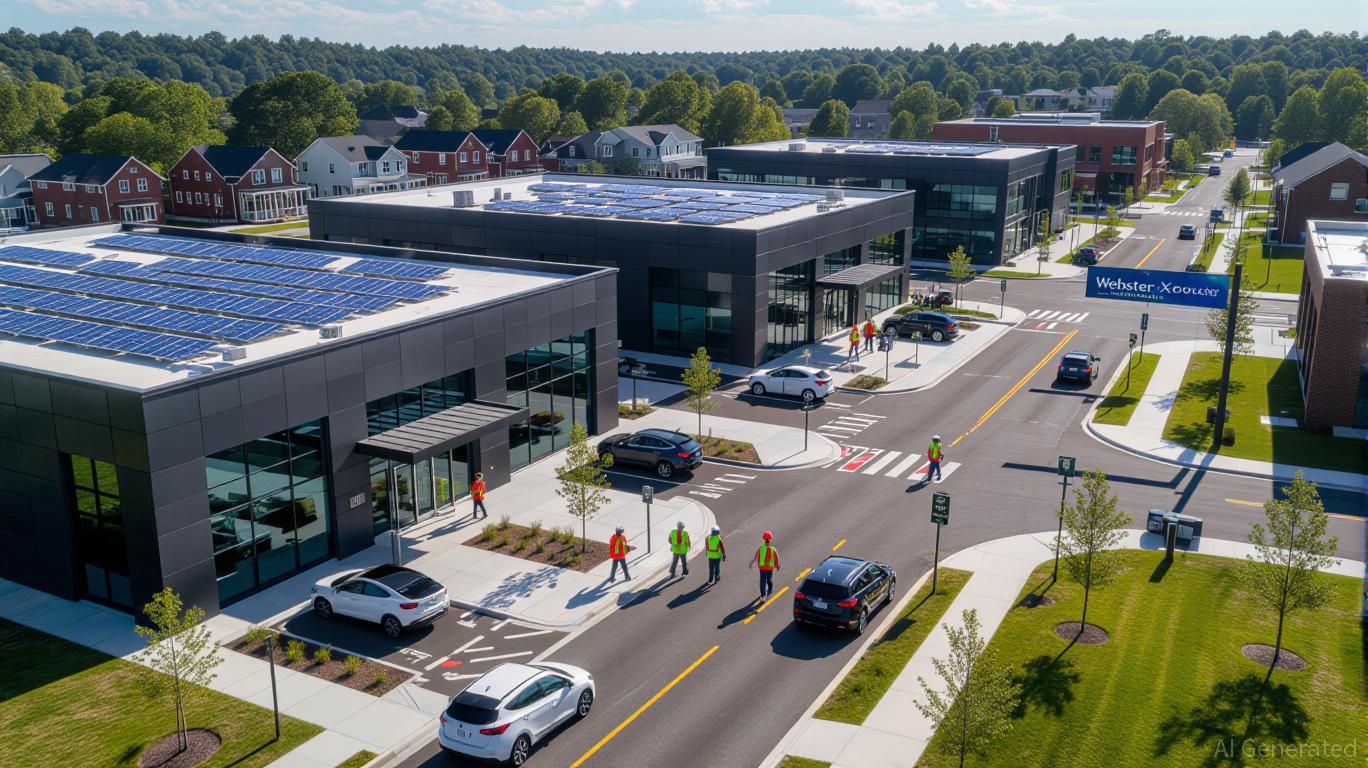Unlocking Potential: The Impact of Overlooked Infrastructure Improvements on Property and Industrial Sector Investments
- Local infrastructure upgrades, often overlooked, drive real estate and industrial growth by enhancing urban mobility and industrial accessibility. - Projects like Atlanta's BeltLine and NYC subway expansions demonstrate how infrastructure boosts property values by 15-20% in adjacent areas. - Industrial real estate thrives on infrastructure investments, with e-commerce fueling demand for last-mile logistics hubs like Dallas-Fort Worth. - Mid-sized/rural cities gain traction as investment targets through s
The Crucial Role of Infrastructure Financing in Local Economic Growth
As cities and towns seek sustainable economic expansion, the financing of infrastructure projects has become a cornerstone for fostering lasting development. While large-scale ventures like major highways or high-speed rail often capture public attention, it is the less-publicized improvements—such as upgrades to wastewater facilities or road repairs in smaller cities—that are quietly transforming investment patterns in real estate and industry. These local projects, frequently overlooked by mainstream investors, are proving instrumental in unlocking new opportunities in both urban and rural settings.
Urban Renewal: Infrastructure as a Catalyst
Infrastructure investments have sparked significant change in cities such as Atlanta and New York. The Atlanta BeltLine, a $3.5 billion project that repurposed an old railway into a multi-use trail, has not only improved transportation but also led to a notable 20% rise in property values in nearby neighborhoods.
Similarly, the extension of New York City's subway system into previously underserved parts of Brooklyn and Queens has enhanced access to employment in Manhattan, resulting in a 15% jump in housing demand and rising property prices. These cases highlight how targeted infrastructure spending can reposition cities as attractive destinations for both living and business.
Industrial properties also benefit from these upgrades. In Webster, NY, a $38 million commitment to transportation and wastewater improvements revitalized underutilized industrial zones, converting them into mixed-use developments and increasing land values by 12% within two years.

Ohio’s statewide efforts, including a $100 million revolving loan fund for residential development, have similarly spurred real estate activity by modernizing aging infrastructure and supporting the redevelopment of previously unused land.
Industrial Real Estate: Infrastructure Fuels Expansion
The demand for industrial real estate is reaching new heights, propelled by the growth of e-commerce and the trend of bringing manufacturing back to the U.S. By 2027, online sales are expected to make up a third of all U.S. retail, increasing the need for efficient last-mile delivery networks. Cities that invest in infrastructure—such as expanding rail connections or upgrading airports—are seeing substantial benefits.
For example, Dallas–Fort Worth has established itself as a logistics powerhouse, thanks to $2.1 billion in infrastructure spending, which has attracted over $15 billion in new industrial construction since 2023.
Smaller industrial developments are also on the rise. Facilities under 100,000 square feet have experienced a 16% year-over-year increase in new projects through the third quarter of 2025, largely due to the needs of e-commerce and adaptable logistics companies. These smaller projects, often found in secondary markets, provide investors with a less risky entry into a sector where prices for compact properties are climbing faster than those for larger sites.
Emerging Opportunities in Mid-Sized and Rural Communities
While much of the conversation centers on major cities, mid-sized and rural communities are becoming increasingly attractive for infrastructure-driven investment. According to the National League of Cities, 88% of local governments see infrastructure as vital for fair economic growth, with 70% focusing on essentials like water, roads, and bridges. Places such as Salt Lake City and Little Elm, Texas have successfully used infrastructure improvements to draw in new residents and businesses, fueling both population growth and real estate demand.
In rural regions, projects like The Standard at West Lafayette in Indiana—a 678-bed housing complex near Purdue University—demonstrate how infrastructure can address housing shortages for workers and stimulate industrial expansion. Likewise, Fayette County, Ohio has become a magnet for industrial investment, thanks to developments like an EV battery plant and an Amazon Web Services data center. A recent housing study predicts the need for 1,400 additional homes in the area by 2033, underscoring the ripple effect of infrastructure spending in less prominent markets.
Investment Strategies: Navigating the Infrastructure Boom
For those looking to invest, the key is to pinpoint municipalities where infrastructure enhancements align with broader economic shifts. Federal initiatives such as the Infrastructure Investment and Jobs Act (IIJA) and the CHIPS Act offer pathways for local governments to access funding, making it easier to focus on projects with strong growth prospects. Public-private partnerships, like San Diego’s Midway Rising project, showcase how collaboration can speed up development while reducing risk.
The evidence is compelling: infrastructure improvements are more than just upgrades to roads and utilities—they are engines of economic transformation. As communities across the United States continue to modernize, both the real estate and industrial sectors are poised for substantial gains. For investors with a long-term perspective, now is the ideal moment to engage with this evolving landscape.
Disclaimer: The content of this article solely reflects the author's opinion and does not represent the platform in any capacity. This article is not intended to serve as a reference for making investment decisions.
You may also like
Bitcoin News Today: Xapo's Enhanced Bitcoin Fund Signals Growing Institutional Confidence in Digital Assets
- Xapo Bank expanded its Byzantine BTC Credit Fund after $100M in institutional allocations, reflecting growing demand for Bitcoin-backed yield products. - The fund uses Hilbert Group's institutional-grade lending process to generate low-risk returns for Bitcoin holders through collateralized loans. - Xapo's expansion follows 2022 lending sector collapse, leveraging regulatory compliance in Gibraltar/Cayman to rebuild institutional trust in Bitcoin collateral. - The product differentiates from ETFs/stablec

Bitcoin News Update: Movements of Investors' USDT Indicate Bitcoin Highs and Periods of Profit Realization
- Bitcoin's price inversely correlates with USDT outflows, as investors shift liquidity between assets during market cycles. - S&P Global downgraded USDT's stability rating to "weak" due to 5.6% Bitcoin allocation and opaque reserves amid U.S. regulatory reforms. - The GENIUS Act and EU's MiCA framework are reshaping stablecoin markets, forcing Tether and Circle to launch jurisdiction-specific, cash-backed alternatives. - Institutional ETF activity, including Texas's Bitcoin purchases and fragmented inflow

The New Prospects for Economic Growth Infrastructure in Webster, NY
- Webster , NY, leverages $9.8M FAST NY grants and PPPs to transform Xerox campus into a high-tech industrial hub. - Infrastructure upgrades including roads, sewers, and electrical systems aim to attract advanced manufacturing and renewable energy firms. - Governor Hochul's strategy drives $51M in upstate investments, creating 250+ jobs via projects like the $650M fairlife® dairy plant. - Redevelopment boosts industrial land availability and residential property values by 10.1%, with mixed-use zoning enhan

The Impact of Artificial Intelligence on Contemporary Portfolio Management: Potential Benefits and Challenges
- AI redefines portfolio management with real-time analytics and dynamic asset allocation, shifting from static human-driven strategies to data-centric systems. - Generative AI tools like ChatGPT automate financial workflows, enabling hyper-personalized strategies and boosting business outcomes through optimized digital presence. - Risk modeling evolves via AI's pattern detection, but challenges persist in transparency and bias, requiring explainable AI frameworks and human oversight. - Institutions integr
